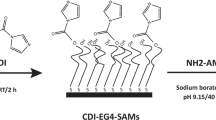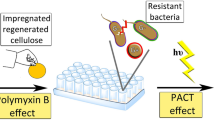Abstract
A robust, efficient, and orthogonal click chemistry (copper (I)-catalyzed alkyne-azide cycloaddition) was used to prepare an antimicrobial polymer and precisely control the conjugation ratio of antibiotic molecules to polymer. Antimicrobial polyurethanes with pendant benzisothiazolinone (PU-BIT) were synthesized using click chemistry to connect azide functional polyurethane (PU-N3) and alkyne functional benzisothiazolinone (BIT-Al). The direct contact-killing and non-leaching antimicrobial properties of PU-BIT were verified by both antimicrobial drop and disk diffusion. This approach provides a new methodology and platform for the development of contact-killing and non-leaching antimicrobial materials for a variety of practical applications. This research is the first to demonstrate that the broad-spectrum BIT antibiotic is a selective antibiotic for Gram-positive bacteria when covalently linked to a polymer. PU-BIT film containing 0.8 wt% BIT exhibited a selective antimicrobial performance with bactericidal efficacy of 91.6% and 30% against Gram-positive Staphylococcus aureus and Gram-negative Escherichia coli, respectively. The mechanism of the selective antimicrobial activity of PU-BIT is also discussed.










Similar content being viewed by others
References
Richards, MJ, Edwards, JR, Culver, DH, Gaynes, RP, “Nosocomial Infections in Medical Intensive Care Units in the United States.” Crit. Care Med., 27 (5) 887–892 (1999)
Kenawy, E-R, Worley, SD, Broughton, R, “The Chemistry and Applications of Antimicrobial Polymers: A State-of-the-Art Review.” Biomacromolecules, 8 (5) 1359–1384 (2007)
Jain, A, Duvvuri, LS, Farah, S, Beyth, N, Domb, AJ, Khan, W, “Antimicrobial Polymers.” Adv. Healthc. Mater., 3 (12) 1969–1985 (2014)
Siedenbiedel, F, Tiller, JC, “Antimicrobial Polymers in Solution and on Surfaces: Overview and Functional Principles.” Polymers, 4 (4) 46–71 (2012)
Dizman, B, Elasri, MO, Mathias, LJ, “Synthesis, Characterization, and Antibacterial Activities of Novel Methacrylate Polymers Containing Norfloxacin.” Biomacromolecules, 6 514–520 (2005)
Turos, E, Shim, JY, Wang, Y, Greenhalgh, K, Reddy, GS, Dickey, S, Lim, DV, “Antibiotic-Conjugated Polyacrylate Nanoparticles: New Opportunities for Development of Anti-MRSA Agents.” Bioorg. Med. Chem. Lett., 17 (1) 53–56 (2007)
Schmidt, M, Bast, LK, Lanfer, F, Richter, L, Hennes, E, Seymen, R, Krumm, C, Tiller, JC, “Poly(2-oxazoline)–Antibiotic Conjugates with Penicillins.” Bioconjugate Chem., 28 (9) 2440–2451 (2017)
Pichavant, L, Carrie, H, Nguyen, MN, Plawinski, L, Durrieu, MC, Heroguez, V, “Vancomycin Functionalized Nanoparticles for Bactericidal Biomaterial Surfaces.” Biomacromolecules, 17 (4) 1339–1346 (2016)
Schmidt, M, Harmuth, S, Barth, ER, Wurm, E, Fobbe, R, Sickmann, A, Krumm, C, Tiller, JC, “Conjugation of Ciprofloxacin with Poly(2-oxazoline)s and Polyethylene Glycol via End Groups.” Bioconjug. Chem., 26 (9) 1950–1962 (2015)
Kawabata, N, “Capture of Micro-Organisms and Viruses by Pyridinium-Type Polymers and Application to Biotechnology and Water Purification.” Prog. Polym. Sci., 17 (1) 1–34 (1992)
Katz, L, Schroeder, W, “Process for the Production of N-benzylidene and N-quinolylmethylene-substituted 2-Aminobenz-isothiazolones.” US 2767172, (1956)
Goerdeler, J, Mittler, W, “Über Isothiazole, III. Synthese von 3-Hydroxy-, 3-Alkoxy- und 3-Amino-isothiazolen.” Chem. Ber., 96 944–954 (1963)
Crow, WD, Leonard, NJ, “3-Isothiazolone-cis-3-Thiocyanoacrylamide Equilibria.” J. Org. Chem., 30 (8) 2660–2665 (1965)
Lewis, SN, Grove, W, Miller, GA and Law, AB, “Certain 2-carbamoyl-3-isothiazolenes.” US 3523121, (1970)
Lewis, SN, Miller, GA, Hausman, M, Szamborski, EC, “Isothiazoles I: 4-Isothiazolin-3-Ones. A General Synthesis from 3,3′-Dithiodipropionamides.” J. Heterocycl. Chem., 8 571–580 (1971)
Williams, TM, “The Mechanism of Action of Isothiazolone Biocides.” Powerpl. Chem., 9, 14–22 (2007)
Morley, JO, Oliver, AJ, Charlton, MH, “Theoretical Studies on the Biocidal Activity of 5-Chloro-3-Isothiazolone.” J. Mol. Struct. Theochem, 429 103–110 (1998)
Khalaj, A, Adibpour, N, Shahverdi, AR, Daneshtalab, M, “Synthesis and Antibacterial Activity of 2-(4-Substituted Phenyl)-3(2H)-Isothiazolones.” Eur. J. Med. Chem., 39 (8) 699–705 (2004)
Huang, C-Y, Hsieh, S-P, Kuo, P-A, Jane, W-N, Tu, J, Wang, Y-N, Ko, C-H, “Impact of Disinfectant and Nutrient Concentration on Growth and Biofilm Formation for a Pseudomonas Strain and the Mixed Cultures from a Fine Papermachine System.” Int. Biodeterior. Biodegrad., 63 (8) 998–1007 (2009)
Lin, QB, Wang, TJ, Song, H, Li, B, “Analysis of Isothiazolinone Biocides in Paper for Food Packaging by Ultra-High-Performance Liquid Chromatography-Tandem Mass Spectrometry.” Food Addit. Contam. Part A Chem. Anal. Control Expo. Risk Assess, 27 (12) 1775–1781 (2010)
Lin, QB, Wang, TJ, Song, H, Wang, RZ, “Kinetic Migration of Isothiazolinone Biocides from Paper Packaging to Tenax and Porapak.” Food Addit. Contam. Part A Chem. Anal. Control Expo. Risk Assess, 28 (9) 1294–1301 (2011)
Thomas, KV, Brooks, S, “The Environmental Fate and Effects of Antifouling Paint Biocides.” Biofouling, 26 (1) 73–88 (2010)
Yang, JX, You, CH, Wang, XH, Lin, Q, “The Synthesis and Bioactivities of 2-Hydroxyethyl Benzo[d] Isothiazole-3(2H)-One Marine Antifouling Paints.” Advanced Materials Research, 646 24–29 (2013)
Schoknecht, U, Wegner, R, Horn, W, Jann, O, “Emission of Biocides from Treated Materials Test Procedures for Water and Air.” Environ. Sci. Pollut., 10 154–161 (2003)
Bordi, F, Mor, M, Plazzi, PV, Silva, C, Morini, G, Impicciatore, M, Barocelli, E, Chiavarini, M, “4-(1,2-Benzisothiazol-3-yl)alkanoic and Phenylalkanoic Acids: Synthesis and Anti-inflammatory, Analgesic and Antipyretic Activities.” Farmaco, 47 551–565 (1992)
Vicinia, P, Amorettia, L, Ballabenib, V, Tognolinib, M, Barocelli, E, “2-Amino-Benzo[d]Isothiazol-3-One Derivatives_ Synthesis and Assessment of Their Antiplatelet_Spasmolytic Effects.” Bioorganic Med. Chem., 8 2355–2358 (2000)
Ballabeni, V, Tognolini, M, Calcina, F, Impicciatore, M, Vicini, P, Barocelli, E, “New Insights into the Pharmacological Properties of Potent Antiplatelet 2-Amino-Benzo [d] Isothiazol-3-One Derivatives.” Pharmacol. Res., 46 389–393 (2002)
Moradi, M, Duan, J, Du, X, “Investigation of the Effect of 4,5-Dichloro-2-n-Octyl-4-Isothiazolin-3-One Inhibition on the Corrosion of Carbon Steel in Bacillus sp. Inoculated Artificial Seawater.” Corros. Sci., 69 338–345 (2013)
Collier, PJ, Ramsey, AJ, Austin, P, Gilbert, P, “Growth Inhibitory and Biocidal Activity of Some Isothiazolone Biocides.” J. Appl. Bacteriol., 69 569–577 (1990)
Chapman, JS, “Biocide Resistance Mechanisms.” Int. Biodeterior. Biodegrad., 51 (2) 133–138 (2003)
Freeman, S, “Allergic Contact Dermatitis Due to 1,2-Benzisothiazolin-3-One in Gum Arabic.” Contact Dermat., 11 (3) 146–149 (1984)
Kagano, H, Goda, H and Sakaue, S, Method for producing alkylsulfinylbenamides and 1-2 benzisothiazol-3-ones. US 5744609, (1998)
Shimizu, M, Takagi, T, Shibakami, M, “Sythesis of 2-(2-Alkoxycarbonyl-phenylthio)-1,2-Benzisothiazolin-3-Ones from 2-Sulfenamoylbenzoates.” Heterocycles, 53 (12) 2803–2808 (2000)
Fuller, SJ, Denyer, SP, Hugo, WB, Pemberton, D, Woodcock, PM, Buckley, AJ, “The Mode of Action of l,2-Benzisothiazolin-3-One On Staphylococcus Aureus.” Lett. Appl. Microbiol., 1 (1) 13–15 (1985)
Collier, PJ, Austin, P, Gilbert, P, “Association and Distribution of Some Isothiazolone Biocides into E. coli ATCC 8739 and S. pombe.” Int. J. Pharm., 66 201–206 (1990)
Diehl, MA, Chapman, JS, “Association of the Biocide 5-Chloro-2-Methyl-Isothiazol-3-One with Pseudomonas aeruginosa and Pseudomonas fluorescens.” Int. Biodeterior. Biodegrad., 44 191–199 (1999)
Zhulenkovs, D, Rudevica, Z, Jaudzems, K, Turks, M, Leonchiks, A, “Discovery and Structure-Activity Relationship Studies of Irreversible Benzisothiazolinone-Based Inhibitors Against Staphylococcus aureus Sortase A Transpeptidase.” Bioorg. Med. Chem., 22 (21) 5988–6003 (2014)
Chung, Y-C, Kim, HY, Choi, JW and Chun, BC, “Preparation of Water-Compatible Antifungal Polyurethane with Grafted Benzimidazole as the Antifungal Agent.” J. Appl. Polym. Sci., 132 (14) 41676–41684 (2015)
Włodarczyk, D, Urban, M, Strankowski, M, “Chemical Modifications of Graphene and Their Influence on Properties Of Polyurethane Composites: A Review.” Phys. Scr., 91 (10) 104003 (2016)
Chung, Y-C, Jo, SH, Kim, HY, Chun, BC, “Characterization and Effect of Covalently Grafted Benzoic Acid on the Low Temperature Flexibility and Water Vapor Permeability of a Polyurethane Copolymer.” Polym. Plast. Technol. Eng., 55 (4) 356–367 (2015)
Fik, CP, Konieczny, S, Pashley, DH, Waschinski, CJ, Ladisch, RS, Salz, U, Bock, T, Tiller, JC, “Telechelic Poly(2-oxazoline)s with a Biocidal and a Polymerizable Terminal as Collagenase Inhibiting Additive for Long-Term Active Antimicrobial.” Dental Materials, 14 (11) 1569–1579 (2014)
Siedenbiedel, F, Fuchs, A, Moll, T, Weide, M, Breves, R, Tiller, JC, “Star-Shaped Poly(styrene)-block-Poly(4-vinyl-N-methylpyridiniumiodide) for Semipermanent Antimicrobial Coatings.” Macromol. Biosci., 13 (10) 1447–1455 (2013)
Vitali, T, Amoretti, L, Mossini, F, “Preparation and Antifungal Effect of Bis-(2-Carboxyamidophenyl) Disulphides and of 1, 2-Benzoisothiazoline-3-One Methoxy Substitutes.” Farmaco, Edizione scientifica, 23 (5) 466–476 (1968)
Ponci, R, Glaldif, F, Baruffini, A, “2,2-Dicarbamido-5,5-Dinitrodiphenyldisulfides and 6-Nitro-1,2-Benzoisothiazolones.” Farmaco Edizione Scientifica, 19 254–268 (1964)
Ponci, R, Vitali, T, Mossini, F, “Bis-(2-Carboxyphenyl) Disulphidediamides and Benzoisothiazolinonic Compounds. Influence of Butylic Residues in the Molecule on the Antifungal Acitivity.” Il Farmaco, Edizione Scientifica, 22 (12) 999–1010 (1967)
Carmellino, ML, Pagani, G, Pregnolato, M, Terreni, M, Pastoni, F, “Antimicrobial Activity of Fluorinated 1,2-Benzisothiazol-3(2H)-Ones and 2,2′-Dithiobis(Benzamides).” Eur. J. Med. Chem., 29 (10) 743–751 (1994)
Hu, J, Peng, K, Guo, J, Shan, D, Kim, GB, Li, Q, Gerhard, E, Zhu, L, Tu, W, Lv, W, Hickner, MA, Yang, J, “Click Cross-Linking-Improved Waterborne Polymers for Environment-Friendly Coatings and Adhesives.” ACS Appl. Mater. Interfaces, 8 (27) 17499–17510 (2016)
Guo, J, Xie, Z, Tran, RT, Xie, D, Jin, D, Bai, X, Yang, J, “Click Chemistry Plays a Dual Role in Biodegradable Polymer Design.” Adv. Mater., 26 (12) 1906–1911 (2014)
Karamdoust, S, Yu, B, Bonduelle, CV, Liu, Y, Davidson, G, Stojcevic, G, Yang, J, Lau, WM, Gillies, ER, “Preparation of Antibacterial Surfaces by Hyperthermal Hydrogen Induced Cross-Linking of Polymer Thin Films.” J. Mater. Chem., 22 (11) 4881 (2012)
Lin, JJ, Lin, WC, Li, SD, Lin, CY, Hsu, SH, “Evaluation of the Antibacterial Activity and Biocompatibility for Silver Nanoparticles Immobilized on Nano Silicate Platelets.” ACS Appl. Mater. Interfaces, 5 (2) 433–443 (2013)
Pielichowska, K, Bieda, J, Szatkowski, P, “Polyurethane/Graphite Nano-Platelet Composites for Thermal Energy Storage.” Renew. Energy, 91 456–465 (2016)
Kutty, SKN, Chaki, TK, Nando, GB, “Thermal Degradation of Short Kevlar Fibrethermoplastic Polyurethane Composite.” Polym. Degrad. Stab., 38 (3) 187–192 (1992)
Petrovic, ZS, Zavargo, Z, Flynn, JH, Macknight, WJ, “Thermal Degradation of Segmented Polyurethanes.” J. Appl. Polym. Sci., 51 (6) 1087–1095 (1994)
Gradwell, MHS, Hourston, DJ, Pabunruang, T, Schafer, F-U, Reading, M, “High-Resolution Thermogravimetric Analysis of Polyurethane/Poly(Ethyl Methacrylate) Interpenetrating Polymer Networks.” J. Appl. Polym. Sci., 70 (2) 287–295 (1998)
Guohua, Z, Ya, L, Cuilan, F, Min, Z, Caiqiong, Z, Zongdao, C, “Water Resistance, Mechanical Properties and Biodegradability of Methylated-Cornstarch/Poly(Vinyl Alcohol) Blend Film.” Polym. Degrad. Stab., 91 (4) 703–711 (2006)
Zharov, VP, Mercer, KE, Galitovskaya, EN, Smeltzer, MS, “Photothermal Nanotherapeutics and Nanodiagnostics for Selective Killing of Bacteria Targeted with Gold Nanoparticles.” Biophys. J., 90 (2) 619–627 (2006)
Borgna, P, Carmellino, ML, Natangelo, M, Pagani, G, Pastoni, F, Pregnolato, M, Terreni, M, “Antimicrobial Activity of N-Hydroxyalkyl 1,2-Benzisothiazol-3(2H)-Ones and Their Thiono Analogues.” Eur. J. Med. Chem., 31 919–925 (1996)
Schneewind, O, Mazmanian, SK, Ton-that, H, “Sortase-Catalysed Anchoring of Surface Proteins to the Cell Wall of Staphylococcus Aureus.” Mol. Microbiol., 40 (5) 1049–1057 (2001)
Pallen, MJ, Chaudhuri, RR, Henderson, IR, “Genomic Analysis of Secretion Systems.” Curr. Opin. Microbiol., 6 (5) 519–527 (2003)
Cozzi, R, Malito, E, Nuccitelli, A, D’Onofrio, M, Martinelli, M, Ferlenghi, I, Grandi, G, Telford, JL, Maione, D, Rinaudo, CD, “Structure Analysis and Site-Directed Mutagenesis of Defined Key Residues and Motives for Pilus-Related Sortase C1 in Group B Streptococcus.” FASEB J., 25 1874–1886 (2011)
Sun, X, Zhang, L, Cao, Z, Deng, Y, Liu, L, Fong, H, Sun, Y, “Electrospun Composite Nanofiber Fabrics Containing Uniformly Dispersed Antimicrobial Agents as an Innovative Type of Polymeric Materials with Superior Antimicrobial Efficacy.” ACS Appl. Mater. Interfaces, 2 (4) 952–956 (2010)
Strassburg, A, Petranowitsch, J, Paetzold, F, Krumm, C, Peter, E, Meuris, M, Köller, M, Tiller, JC, “Cross-Linking of a Hydrophilic, Antimicrobial Polycation Toward a Fast-Swelling, Antimicrobial Superabsorber and Interpenetrating Hydrogel Networks with Long Lasting Antimicrobial Properties.” ACS Appl. Mater. Interfaces, 9 (42) 36573–36582 (2017)
Acknowledgments
This work was supported by the National Natural Science Foundation of China (21762036) and Foundation for High-level Talents in Qiannan Normal University for Nationalities and Qiankehe LH [2015]7706.
Author information
Authors and Affiliations
Corresponding author
Rights and permissions
About this article
Cite this article
Peng, K., Dai, X., Mao, H. et al. Development of direct contact-killing non-leaching antimicrobial polyurethanes through click chemistry. J Coat Technol Res 15, 1239–1250 (2018). https://doi.org/10.1007/s11998-018-0068-1
Published:
Issue Date:
DOI: https://doi.org/10.1007/s11998-018-0068-1




